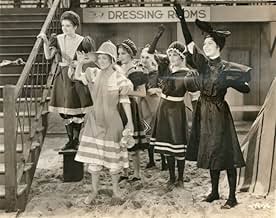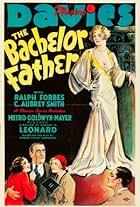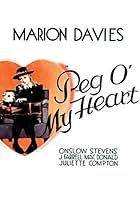IMDb RATING
6.0/10
1.4K
YOUR RATING
A New York chorus girl's friends encourage her to pursue a handsome socialite.A New York chorus girl's friends encourage her to pursue a handsome socialite.A New York chorus girl's friends encourage her to pursue a handsome socialite.
- Awards
- 2 wins total
Jack Baxley
- Carriage Driver
- (uncredited)
Lenore Bushman
- Florordora Sextette Member
- (uncredited)
Featured reviews
Marion Davies is quite good in her 3rd talkie, THE FLORODORA GIRL, playing one of the 1890s stage sensations. While the other girls are raking in jewelry and marrying wealthy men, Davies can't quite figure out the game and waits for Mr. Right. He appears in the person of society man, Jack Vibart (Lawrence Gray), but he has a terrible reputation as a womanizer and is engaged to a socialite. The girls decide to teach Davies how to play the game to rake in the loot, but she really doesn't want to scam Vibart. Turns out he is a fortune hunter since his family is broke. Can the lovers united? Several plot devices later, there is a happy, 2-strip Technicolor ending, possibly the only color footage Davies appears in.
Nice film, accurate depiction of 1890s America. This film again proves the wonderful comedic talents of Marion Davies and draws from her early days on Broadway as a Ziegfeld Girl and musical star. She's marvelous, and so is Gray.
Good supporting cast with Ilka Chase, Sam Hardy, George Chandler, Jed Prouty, Nance O'Neil, Vivian Oakland, Walter Catlett, Maude Turner Gordon, Anita Louise, and Louis John Bartels.
Best scenes include Davies all dolled up in a makeshift gown from the theater's costume department, crashing a society ball and the color finale, which finally shows the musical routine that had the theater world agog: "Tell Me, Pretty Maiden." Sweet, innocent film, and very well done. Davies and Gray had starred together in the silent classic, THE PATSY, as well as Davies' starring talkie debut in MARIANNE.
Nice film, accurate depiction of 1890s America. This film again proves the wonderful comedic talents of Marion Davies and draws from her early days on Broadway as a Ziegfeld Girl and musical star. She's marvelous, and so is Gray.
Good supporting cast with Ilka Chase, Sam Hardy, George Chandler, Jed Prouty, Nance O'Neil, Vivian Oakland, Walter Catlett, Maude Turner Gordon, Anita Louise, and Louis John Bartels.
Best scenes include Davies all dolled up in a makeshift gown from the theater's costume department, crashing a society ball and the color finale, which finally shows the musical routine that had the theater world agog: "Tell Me, Pretty Maiden." Sweet, innocent film, and very well done. Davies and Gray had starred together in the silent classic, THE PATSY, as well as Davies' starring talkie debut in MARIANNE.
"Floradora Girl" is an early sound picture that starred Marion Davies and a little known Lawrence Gray. Both had been leads in silent films and had some success transitioning to sound. But his career faded fast as many new male actors were getting established in sound pictures. Davies' career also faded fast, but that was mostly because of her personal life. She wasn't a great actress, but a good one in several films. It depended on the material she got, and a few years into sound pictures, she wasn't getting the scripts that many new and up-and-coming actresses were getting.
The plot for this film isn't exceptional, but Davies is okay as Daisy. The cast is sizable, but except for a couple supporting actors, there are few familiar faces in this cast. What lifts this film some, is its very good portrayal of some period things of history. The setting is supposed to be in the 1890s. Of special interest to sports fans are scenes of a football game that show players with minimum equipment, and a couple of very unusual plays, including, the wedge.
There is some humor - the funniest scene being efforts by a crowd of people to resuscitate Daisy (Davies) after she faked drowning to be rescued by Jack (Gray). Except for the scenes of turn of the 20th century things of interest, there isn't a lot to recommend this film as above average run-of-the-mill.
The plot for this film isn't exceptional, but Davies is okay as Daisy. The cast is sizable, but except for a couple supporting actors, there are few familiar faces in this cast. What lifts this film some, is its very good portrayal of some period things of history. The setting is supposed to be in the 1890s. Of special interest to sports fans are scenes of a football game that show players with minimum equipment, and a couple of very unusual plays, including, the wedge.
There is some humor - the funniest scene being efforts by a crowd of people to resuscitate Daisy (Davies) after she faked drowning to be rescued by Jack (Gray). Except for the scenes of turn of the 20th century things of interest, there isn't a lot to recommend this film as above average run-of-the-mill.
The late 1890's are lovingly reconstructed, with wonderful costumes and nice sets. Very good script. Marion Davies as a chorus girl who doesn't want to be a rich man's toy has lots of chances to show her stuff. There is only one Floradora dance routine and it is quite calm. The final scenes are in two color Technicolor.
A rich young man woos THE FLORODORA GIRL of his dreams -- but is he sincere?
For nearly 20 years, no other actress in America was the recipient of so much effort to make her a big movie star than Marion Davies. As mistress of the powerful media mogul, William Randolph Hearst, Davies appeared in one lavish film production after another. Hearst's seemingly bottomless pockets spared no expense and Marion lived like a queen both on screen and off. (Their huge California mansion, now called Hearst Castle, crowned a coastal estate of unstinted extravagance, while the saltwater sequence for FLORODORA GIRL was filmed in the waters in front of the enormous Santa Monica beach house Hearst built for her.)
Never one to put on airs, Davies won the hearts of her fans and the other Hollywood stars with her warm generosity and good spirits. On the screen Hearst preferred seeing her in heavy historical romances, but she much more enjoyed light comedy fare which better displayed her talents. Which is exactly what she does in FLORODORA GIRL, getting to sing & dance a little, playing a member of the famed sextet, looking for love with the right boy but not willing to compromise her morals in the search. Davies had been a Ziegfeld Follies Girl before being carried off by Hearst; the film poses a few questions about love and success which must have given Marion something to ponder.
Lawrence Gray, an important MGM musical comedy star at the beginning of the Sound Era, does well in his role as the vivacious society boy who learns a few things about maturity while wooing Davies. He had partnered with Marion before, in Silent & Sound pictures, and they have a good on-screen chemistry.
The supporting cast provide a few laughs: Walter Catlett, Louis John Bartels & Claud Allister as well-heeled stage door Johnnies; Ilka Chase & Vivian Oakland as aging, tough-as-nails Florodora Girls; Jed Prouty as Marion's alcoholic father; and George Chandler as her big-toothed cigar store boyfriend. That's Anita Louise who shows up very briefly as one of Gray's younger sisters.
MGM gave the film a nice feeling of the 1890's with its horseless carriages, puffed sleeve fashions and frequent songs. The early Technicolor with which the film closes is most pleasing to the eye.
For nearly 20 years, no other actress in America was the recipient of so much effort to make her a big movie star than Marion Davies. As mistress of the powerful media mogul, William Randolph Hearst, Davies appeared in one lavish film production after another. Hearst's seemingly bottomless pockets spared no expense and Marion lived like a queen both on screen and off. (Their huge California mansion, now called Hearst Castle, crowned a coastal estate of unstinted extravagance, while the saltwater sequence for FLORODORA GIRL was filmed in the waters in front of the enormous Santa Monica beach house Hearst built for her.)
Never one to put on airs, Davies won the hearts of her fans and the other Hollywood stars with her warm generosity and good spirits. On the screen Hearst preferred seeing her in heavy historical romances, but she much more enjoyed light comedy fare which better displayed her talents. Which is exactly what she does in FLORODORA GIRL, getting to sing & dance a little, playing a member of the famed sextet, looking for love with the right boy but not willing to compromise her morals in the search. Davies had been a Ziegfeld Follies Girl before being carried off by Hearst; the film poses a few questions about love and success which must have given Marion something to ponder.
Lawrence Gray, an important MGM musical comedy star at the beginning of the Sound Era, does well in his role as the vivacious society boy who learns a few things about maturity while wooing Davies. He had partnered with Marion before, in Silent & Sound pictures, and they have a good on-screen chemistry.
The supporting cast provide a few laughs: Walter Catlett, Louis John Bartels & Claud Allister as well-heeled stage door Johnnies; Ilka Chase & Vivian Oakland as aging, tough-as-nails Florodora Girls; Jed Prouty as Marion's alcoholic father; and George Chandler as her big-toothed cigar store boyfriend. That's Anita Louise who shows up very briefly as one of Gray's younger sisters.
MGM gave the film a nice feeling of the 1890's with its horseless carriages, puffed sleeve fashions and frequent songs. The early Technicolor with which the film closes is most pleasing to the eye.
Marion Davies is the last of the original New York Florodora Girls who hasn't married a millionaire. She's an unsophisticated girl, despite her surroundings. She has attracted numerous admirers of the masculine persuasion. Some of them have intentions that are less than honorable. However young Lawrence Grey has standing in the Four Hundred as well as a considerable fortune, and seems to love her sincerely.
Harry Beaumont directs his performers as always performing, playing sophisticates without any real sophistication. To an audience that was coming out of the Roaring Twenties into the Depression, with Warner Brothers about to plumb the pre-code depths of the gangster film, it might have been nostalgic for a bygone, simpler era. It certainly works that way for me, and the slightly degraded 2-strip Technicolor finale adds to the effect.
Nance O'Neil is charming in the unwelcome role of the mother telling Miss Davies toget her paws off her son. With Walter Catlett, Ilka Chase, Vivien Oakland, Jed Prouty, and of course George Chandler.
Harry Beaumont directs his performers as always performing, playing sophisticates without any real sophistication. To an audience that was coming out of the Roaring Twenties into the Depression, with Warner Brothers about to plumb the pre-code depths of the gangster film, it might have been nostalgic for a bygone, simpler era. It certainly works that way for me, and the slightly degraded 2-strip Technicolor finale adds to the effect.
Nance O'Neil is charming in the unwelcome role of the mother telling Miss Davies toget her paws off her son. With Walter Catlett, Ilka Chase, Vivien Oakland, Jed Prouty, and of course George Chandler.
Did you know
- TriviaThis was the film which opened the famous Pantages Theatre at Hollywood and Vine.
- GoofsIn the beach scene, which begins Reel #3 @ 0:18:40, the opening shot begins with the clapper boy crossing the set with clapper in hand, obviously a modern day printing error in the version presently in circulation which 1930 audiences would not have witnessed.
- ConnectionsFeatured in Captured on Film: The True Story of Marion Davies (2001)
- SoundtracksMy Kind of Man
(1930) (uncredited)
Music by Herbert Stothart
Lyrics by Clifford Grey and Andy Rice
Performed by Lawrence Gray and chorus
Details
- Release date
- Country of origin
- Language
- Also known as
- The Florodora Girl (A Story of the Gay Nineties)
- Filming locations
- Production companies
- See more company credits at IMDbPro
- Runtime1 hour 19 minutes
- Color
Contribute to this page
Suggest an edit or add missing content





































